Seminar in the Analysis and Methods of PDE
The Seminar in the Analysis and Methods of PDE (SIAM PDE) is an initiative of SIAM Journal on Mathematical Analysis (SIMA) and the SIAM Activity Group on Analysis of Partial Differential Equations (SIAG/APDE). The webinar series will be held on the first Thursday of the month at 11:30 a.m. ET, except in August and January. Find past recorded webinars on SIAM's YouTube channel.
Organizing Committee
Upcoming Webinars
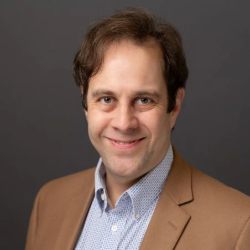
Speaker Name: Robert McCann
Speaker Affiliation: University of Toronto
Date and Time: February 26, 2025, at 10 a.m. ET
Chair: Marcelo Disconzi, Venderbilt University
Talk Title: The monopolist's free boundary problem in the plane: an excursion into the economic value of private information
Abstract: The principal-agent problem is an important paradigm in economic theory for studying the value of private information: the nonlinear pricing problem faced by a monopolist is one example; others include optimal taxation and auction design. For multidimensional spaces of consumers (i.e. agents) and products, Rochet and Chone (1998) reformulated this problem as a concave maximization over the set of convex functions, by assuming agent preferences are bilinear in the product and agent parameters. This optimization corresponds mathematically to a convexity-constrained obstacle problem. The solution is divided into multiple regions, according to the rank of the Hessian of the optimizer.
Apart from four possible pathologies, if the monopolists costs grow quadratically with the product type we show that a smooth free boundary delineates the region where it becomes efficient to customize products for individual buyers. We give the first complete solution of the problem on square domains, and discover new transitions from unbunched to targeted and from targeted to blunt bunching as market conditions become more and more favorable to the seller. Based on work with Cale Rankin of Monash University and Kelvin Shuangjian Zhang of Fudan University.
Biography: Robert McCann has made fundamental contributions to optimal transport theory. His discovery of displacement convexity and his solution to Monge’s (1746-1818) problem for different transportation costs were early, foundational advances that preceded by nearly 30 years the current enormous attention bestowed on optimal transport theory and its applications. Beyond these, McCann produced many important, unexpected results, linking optimal transport to new areas of application within and outside mathematics: different notions of curvature, new and hidden convexities in the economics of information, and a nonsmooth theory of gravity based on the interaction of entropy with the Einstein field equation. His research has been recognized by awards such as an invitation to lecture at the 2014 International Congress of Mathematicians in Seoul; election to the Royal Society of Canada in 2014; the 2017 Jeffery-Williams Prize of the Canadian Mathematical Society; the 2023 SIAM W. T. and Idalia Reid Prize and the 2025 Norbert Wiener Prize of the American Mathematical Society and SIAM. McCann holds a Canada Research Chair in Mathematics, Economics, and Physics at the University of Toronto. He serves on the editorial board of the SIAM Journal of Mathematical Analysis, and as editor-in-chief of the Canadian Journal of Mathematics since 2007.
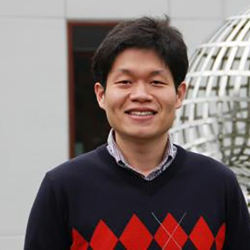
Speaker Name: Chanwoo Kim
Speaker Affiliation: University of Wisconsin
Date and Time: February 26, 2025, at 11:30 a.m. ET
Chair: Marcelo Disconzi, Venderbilt University
Talk Title: Quantitative Theory of Hydrodynamic Limits Toward Incompressible Euler Equations
Featured article: "Vorticity convergence from Boltzmann to 2D incompressible Euler equations below Yudovich class," SIAM Journal on Mathematical Analysis 56 (3) pp. 3144 - 3202 (2024).
Featured article authors: Chanwoo Kim and Joonhyun La
Abstract: In this talk, I will discuss quantitative convergence results for scaled Boltzmann solutions approaching solutions of the incompressible Euler equations as the Knudsen number tends to zero, without requiring prior knowledge of the limiting solution.
Biography: Chanwoo Kim is a professor of mathematics at the University of Wisconsin-Madison. He earned his Ph.D. in mathematics from Brown University in 2011. Dr. Kim's research focuses on the areas of partial differential equations and kinetic theory. His research has received recognition in several ways including an NSF CAREER Award, a Simons Fellowship, and a Brain Pool Fellowship.
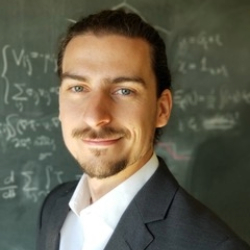
Speaker Name: Tim Laux
Speaker Affiliation: University of Regensburg, Germany
Date and Time: February 27, 2025, at 10 a.m. ET
Chair: Atanas Stefanov, University of Alabama, Birmingham
Talk Title: The sharp-interface limit of the Allen-Cahn equation
Featured article: "Convergence rates of the Allen-Cahn equation to mean curvature flow: A short proof based on relative entropies," SIAM Journal on Mathematical Analysis 52 (6) pp. 6222 - 6233 (2020).
Featured article authors: Julian Fischer, Tim Laux, and Theresa M. Simon
Abstract: The Allen-Cahn equation is one of the most basic reaction-diffusion equations, modeling a large variety of phase transition problems. In a suitable scaling limit, the transition becomes sharp and the system follows a geometric evolution equation - the mean curvature flow. The structure of this "sharp-interface limit" has received continuous attention from both the geometric and applied analysis communities over the last decades. In this talk, I will give an overview of some of the breakthroughs in this field and highlight a recent short convergence analysis in a joint work with Julian Fischer and Theresa Simon. Our proof is based on a new relative entropy for diffuse interface problems that allows us to prove the optimal convergence rate toward mean curvature flow.
Biography: Tim Laux is a full professor of mathematics at the University of Regensburg in Germany. Previously, he was a Bonn Junior Fellow at the Institute for Applied Mathematics and the Hausdorff Center for Mathematics in Bonn, as well as a Morrey Visiting Assistant Professor at the University of California, Berkeley. He completed his Ph.D. in 2017 under the supervision of Felix Otto at the Max Planck Institute for Mathematics in the Sciences, for which he received the Otto Hahn Medal.
Tim describes himself as an applied geometric analyst. Using methods from geometric analysis, the calculus of variations, and nonlinear partial differential equations, he addresses fundamental questions in physics, materials science, numerical analysis, and data science. His work rigorously justifies the emergence of geometric variational principles and geometric flows in complex systems.
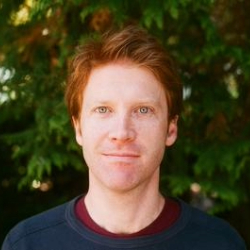
Speaker Name: Andrew Lawrie
Speaker Affiliation: University of Maryland, College Park
Date and Time: February 27, 2025, at 11:30 a.m. ET
Chair: Atanas Stefanov, University of Alabama, Birmingham
Talk Title: Soliton dynamics for classical scalar fields
Abstract: I will present some of my recent work with Jacek Jendrej. We study classical scalar fields in dimension 1+1 with a symmetric double-well self-interaction potential. Examples of such equations are the phi-4 model and the sine-Gordon equation. These nonlinear wave equations admit non-trivial static solutions called kinks and antikinks, which are amongst the simplest examples of topological solitons. We define an n-kink cluster to be a solution approaching, for large positive times, a superposition of n alternating kinks and antikinks whose velocities converge to zero and mutual distances grow to infinity. Our main result is a determination of the leading order asymptotic behavior of any n-kink cluster. We use this information to construct the n-dimensional invariant manifold of n-kink clusters, which plays the dynamical role of the stable/unstable manifold for an ideal "critical point at infinity” given by well separated multi-kink configurations. In this context, we also explain the role of kink clusters as universal profiles for the formation/annihilation of multikink configurations.
Biography: Andrew Lawrie received his Ph.D. from the University of Chicago in 2013. He then served as an NSF postdoctoral fellow at the University of California, Berkeley, before joining the Massachusetts Institute of Technology as an assistant professor. In 2024, he became a professor of mathematics at the University of Maryland.
Future Webinars
Date and Time: TBA
Speaker: TBA
Past Webinars
2024
Speaker Name: Nader Masmoudi
Speaker Affiliation: New York University-Abu Dhabi, UAE & Courant Institute, NYU
Date of Presentation: May 2, 2024, at 11:30 a.m. ET
Chair: Slim Ibrahim, University of Victoria
Title: Recent Progress in the Study of the Prandtl System and the Zero Viscosity Limit
Abstract: The Prandtl system describes the evolution in the boundary layer that forms near the boundary when taking the inviscid limit in the Navier-Stokes system. It was first derived in 1904 by Prandtl. Many important questions related to the Prandtl system and the inviscid limit are still open. I will review some recent advances in the study of the well-posedness of the Prandtl system, the separation of the boundary layer, as well as the study of the inviscid limit of the Navier-Stokes system and the Derivation of the Prandtl system.
Biography: Nader Masmoudi received his degree in mathematics from the École Normale Supérieure Paris (1996), his Ph.D. from Paris Dauphine University (1999), and his HDR (2000). He won the gold medal at the International Mathematic Olympiads (1992), was first at the Concours of École Normale Supérieure and Ecole Polytechnique (1994), and won a Presidential prize in Tunisia (1994). He also received a Senior Clay Math Scholar (2014) and a chair of excellence from the Foundation Sciences Mathématiques de Paris (2016-2017).
Nader Masmoudi was awarded the 2017 Fermat Prize for his remarkable work of depth and creativity in the analysis of non-linear partial differential equations, and in particular, for his contributions to the rigorous and complete resolution of hydrodynamic stability problems raised at the end of the 19th century by founding fathers of modern fluid mechanics.
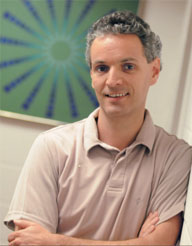
Speaker Name: Guillaume Bal
Speaker Affiliation: University of Chicago
Date of Presentation: April 4, 2024
Chair: Eric Bonnetier, Fourier Institute, Grenoble-Alpes University
Title: Aysmmetric interface transport and topological insulators
Featured article: "Edge State Dynamics Along Curved Inferfaces," SIAM Journal on Mathematical Analysis 55 (5) pp. 4219-4254 (2023).
Featured article authors: Guillaume Bal, Simon Becker, Alexis Drouot, Clotilde Fermanian Kammerer, Jianfeng Lu, and Alexander B. Watson
Abstract: The surprising robustness to perturbation of the asymmetric transport observed along interfaces separating distinct insulating bulks affords a topological origin. This talk reviews a classification of partial differential operators modeling such systems. We establish a bulk-edge correspondence relating the quantized interface transport to the index of a Fredholm operator naturally associated to the insulating bulks. We also present a scattering theory that describes the interface transport more quantitatively. The theory is illustrated with examples of application in condensed matter physics and geophysics.
Biography: Guillaume Bal is a professor of applied mathematics at the University of Chicago and the current director of its Committee of Computational and Applied Mathematics. He received a Ph.D. in mathematics from the University of Paris 6 in 1997 and has held postdoctoral and faculty positions at Stanford University, Columbia University, and The University of Chicago.
His research interests primarily revolve around the interplay between the constitutive coefficients and the solutions of partial differential equations. This finds applications in the theory of inverse problems, in particular inverse kinetic problems and the class of high-resolution high-contrast hybrid imaging modalities, in the derivation of mesoscopic models such as kinetic and diffusive equations in the analysis of wave propagation in highly heterogeneous media. And more recently, in the role of non-trivial topologies to explain unusual phenomena such as transport that is robust to perturbations and a quantized obstruction to Anderson localization.
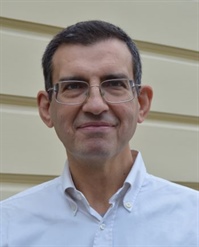
Speaker Name: Luigi Ambrosio
Speaker Affiliation: Scuola Normal Superiore, Pisa, Italy
Date of Presentation: March 7, 2024
Chair: Alberto Bressan, Penn State University
Title: On some variational problems involving functions with bounded Hessian
Abstract: In this talk I will illustrate new questions, at the interface between Calculus of Variations and Geometric Measure Theory, motivated in a broad sense by the more applied machine learning community. More specifically, I will deal with second-order variational problems in the setting of functions with bounded variation and study the extremality properties of continuous and piecewise affine functions in the unit ball of a suitable energy, used as a regularization term in the applied community. In connection with this, a fine approximation result by piecewise affine function has been investigated. Papers in collaboration with C.Brena, S.Conti, S.Aziznejad, and M.Unser.
Biography: Luigi Ambrosio has been a full professor of mathematical analysis at the Scuola Normale since 1998. As a student of the Scuola Normale, he graduated in mathematics from the University of Pisa and subsequently held positions as a professor of mathematical analysis at the University of Pisa, the University of Salerno, and then at the University of Pavia. His main research interests are in calculus of variations, geometric measure theory, optimal transport theory, and their applications to partial differential equations.
Dr. Ambrosio was a member of the editorial committee of Archive for Rational Mechanics and Analysis, Calculus of Variations and Partial Differential Equation and the Journal of the European Mathematical Society; was an invited speaker at the II European Congress in Budapest (1996 and the International Congress of Mathematics in Beijing (2002); and was a plenary speaker at the International Congress of Mathematics in Rio De Janeiro (2018). He is a corresponding member of the Accademia Nazionale dei Lincei and the Istituto Lombardo, Accademia di Scienze e Lettere. Since 2019, he has been the Director of the Scuola Normale Superiore.
He has been awarded several prizes for his research activities, including the National Prize for Mathematics and Mechanics from the Italian Ministry of Research and University (1996), the Caccioppoli Prize from the Italian Mathematical Union (1999), the Fermat Prize from the Université de Toulouse (2003), the Gold Medal for Mathematics, conferred by the Accademia Nazionale dei XL (2015), the Balzan Prize (2019), and the Riemann Prize (2023).
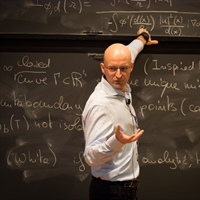
Speaker Name: Camillo De Lellis
Speaker Affiliation: Institute for Advanced Studies, Princeton University
Date of Presentation: February 1, 2024
Chair: Emil Wiedemann, University of Erlangen-Nürnberg (Friedrich-Alexander-Universität), Erlangen, Germany
Title: Area-minimizing integral currents: singularities and structure
Abstract: Area-minimizing integral currents were introduced by De Giorgi, Federer, and Fleming to build a successfull existence theory for the {\em oriented} Plateau problem. While celebrated examples of singular minimizers were discovered soon after, a first theorem which summarizes the work of several mathematicians in the 60es and 70es (De Giorgi, Fleming, Almgren, Simons, and Federer) and a second theorem of Almgren from 1980 give general dimension bounds for the singular set which match the one of the examples, in codimension $1$ and in general codimension respectively.
In joint works with Anna Skorobogatova and Paul Minter we prove that in higher codimension the singular set is $(m-2)$-rectifiable and the tangent cone is unique at $\mathcal{H}^{m-2}$-a.e. point. Independently and at the same time, a proof of the same result has been discovered also by Krummel and Wickramasekera. This theorem is the counterpart, in general codimension, of a celebrated work of Leon Simon in the nineties for the codimension $1$ case. Moreover, a recent theorem by Liu proves that the singular set can in fact be a fractal of any Hausdorff dimension $\alpha \leq m-2$, indicating that the above structure theorem is indeed close to optimal.
Biography: Camillo De Lellis is an Italian and Swiss mathematician, born in San Benedetto del Tronto, Italy, in 1976. He received his Ph.D. in mathematics from the Scuola Normale Superiore at Pisa (2002). He was Full Professor of Mathematics at the University of Zuerich (2005-2018), before moving to Princeton University, where he currently is the IMB von Neumann Professor. Dr. De Lellis' work encompasses problems in fluid dynamics, geometric measure theory, and the calculus of variations.
2023
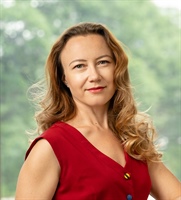
Speaker Name: Svitlana Mayboroda
Date of Presentation: December 7, 2023
Chair: Guy David, Université de Paris Sud (Orsay), France
Title: Wave Localization and the Landscape Law
Abstract: Waves of all kinds permeate our world. We are surrounded by light (electromagnetic waves), sound (acoustic waves), and mechanical vibrations. Quantum mechanics revealed that, at the atomic level, all matter has a wavelike character, and classical gravitational waves have been very recently detected. At the cutting edge of today’s science, it has become possible to manipulate individual atoms. This provides us with precise measurements of a world that exhibits myriad irregularities — dimensional, structural, orientational, and geometric— simultaneously. For waves, such disorder changes everything. In complex, irregular, or random media, waves frequently exhibit astonishing and mysterious behavior known as ‘localization’. Instead of propagating over extended regions, they remain confined in small portions of the original domain. The Nobel Prize–winning discovery of the Anderson localization in 1958 is only one famous case of this phenomenon. Yet, 60 years later, despite considerable advances in the subject, we still notoriously lack tools to fully understand localization of waves and its consequences. In the present talk we show that behind a possibly disordered system there exists a structure, a ``landscape", which can predict the location and shape of the localized eigenfunctions, a pattern of their exponential decay, and deliver accurate bounds for the corresponding eigenvalues. In particular, we establish the first non-asymptotic estimates on the integrated density of states of the Schrödinger operator using a counting function for the minima of the localization landscape, and discuss the first results towards the prediction of Wigner functions and ultimately of general quantum observables.
Biography: Svitlana Mayboroda was born in Kharkiv, Ukraine. She received her Ph.D. at the University of Missouri in 2005, and then held postdoctoral positions at the Ohio State University, Australian National University, and Brown University. She worked at Purdue University (2008-2011) before moving to the University of Minnesota in 2011. Dr. Mayboroda has been the McKnight Presidential Professor of Mathematics at the University of Minnesota since 2020. In 2023, she joined ETH Zurich.
Svitlana Mayboroda's awards include the US Blavatnik National Award (2023), the AWM-Sadosky Prize in Analysis (2014), and the Alfred P. Sloan Research Fellowship (2010). Additionally, she was an invited speaker at the 2018 International Congress of Mathematicians. Since 2018, Dr. Mayboroda has been the Director of the Simons Collaboration on the Localization of Waves, a large interdisciplinary project devoted to the behavior of waves in disordered media.

Speaker Name: Eduard Feireisl
Date of Presentation: November 2, 2023
Chair: Hideo Kozono, Waseda and Tohoku University
Title: Dissipative systems in Fluid Dynamics
Featured article: "Compressible Navier--Stokes System with Transport Noise," SIAM Journal on Mathematical Analysis, Vol. 54, No. 4, pp. 4465–4494, (2022)
Featured article authors: Dominic Breit, Eduard Feireisl, Martina Hofmanová, and Ewelina Zatorska
Abstract: A dissipative system is a thermodynamically open system in the far from equilibrium regime exchanging matter and energy with the outer world. Most of the real-world phenomena fall in this category. The dissipative systems enjoy a complex behaviour, develop patterns or structures while dissipating energy. Dissipative systems in continuum fluid dynamics are modelled by evolutionary partial differential equations, where communication with the outer world is enabled through a proper choice of boundary conditions.
The main challenges addressed in the talk are:
(i) Dissipativity in the sense of Levinson - or - the existence of bounded absorbing sets
(ii) Asymptotic compactness of global trajectories
(iii) Systems driven by random data
Biography: Eduard Feireisl is Senior Researcher at the Institute of Mathematics of the Czech Academy of Sciences and Full Professor at Charles University in Prague. He authored or coauthored over 300 research papers and seven monographs. Professor Feireisl's main research interest lies in the analysis of partial differential equations with application in fluid mechanics, including numerical analysis and the effect of stochastic phenomena. He is one of the leading experts in the field of mathematical fluid mechanics.
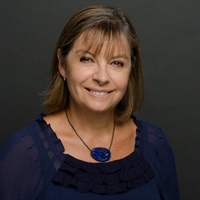
Speaker Name: Irene Gamba
Date of Presentation: October 5, 2023
Chair: Renjun Duan, Chinese University of Hong Kong
Title: Weak turbulence modeled by quasilinear diffusion for electrostatic and magnetized plasma systems
Abstract: Quasilinear diffusion models for electrostatic and highly magnetized plasma systems arise under small perturbations of equilibrium states. They are model reductions of mean field systems from Vlasov-Maxwell in nonequilibrium states, under the validity of ergodic and random phase approximation regimes, coupling particles in momenta and Lorentz forces in spectral space through a dispersion relation governed by a bulk pdf state. These quasilinear mean field systems exhibit instabilities from moving Gaussians which derail the approximation of Maxwellian limiting states for long time. In the particular case of electrostatic models, a one-dimensional model arises for momenta-spectral space system that admits existence of global in time solutions in Sobolev spaces and higher regularity. The proof is inspired by techniques from Porous media flow models with non-linear gradient forms and source terms. Their stationary states may not be a Maxwellian distributions in momenta space. In addition, we will discuss these effects by numerical approximations to non-equilibrium statistical states. This is recent work in collaboration with Kun Huang for the analytical properties in the electrostatic case model, as well as with Kun Huang, Michael Abdelmalik and Boris Briezman (Jour. Comp. Physics, June 2023).
Biography: Irene M. Gamba is a professor of mathematics at the University of Texas, Austin (UT Austin) and director of the Applied Mathematics Group at the Oden Institute. She holds the W.A. “Tex” Moncrief, Jr. Chair in Computational Engineering and Sciences III. She earned her Ph.D. in mathematics at the University of Chicago in 1989. She held a National Science Foundation (NSF) postdoctoral fellowship at the Courant Institute at New York University, where she later became an assistant and associate professor before coming to UT Austin in 1997 as a full professor.
Her scientific interests are analytical and computational issues in collisional kinetic theory, including the evolution of Boltzmann and Landau type equations in mean field regimes, gas mixture systems, and quantum-Boltzmann systems. Applications of these models range from plasma dynamics in mean-field theories such as electron runaway transport, Tokamak dynamics, charged transport in nanodevices, and coupling of quantum-kinetic gas systems.
Watch the Presentation
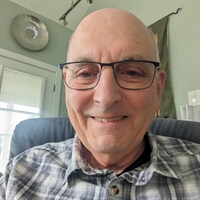
Speaker: Christopher K.R.T. Jones
Date of Presentation: September 7, 2023
Chair: Carola-Bibiane Schönlieb, Cambridge University
Title: Stability Indices for Nonlinear Waves and Patterns
Featured article: "Generalized Maslov Indices for Non-Hamiltonian Systems," SIAM Journal on Mathematical Analysis 54 (2) pp. 1623-1668 (2022).
Featured article authors: Thomas J. Baird, Paul Cornwell, Graham Cox, Christopher Jones, and Robert Marangell
Abstract: For a steady state of a nonlinear PDE, its stability is generally captured by a count of the unstable eigenvalues. The Evans Function and Maslov Index offer two approaches that are each appropriate for determining this index in certain types of problem. They both encode information from the geometry of the underlying state and the associated eigenvalue equations. However, the Maslov Index is more stringent in its requirements of the underlying PDE. I will discuss ways in which both theories have been pushed in recent years to cover more complex problems than those for which they were originally intended.
Biography: Christopher K.R.T. Jones is the Bill Guthridge Distinguished Professor Emeritus of Mathematics at the University of North Carolina at Chapel Hill. He received his Ph.D. in mathematics from the University of Wisconsin-Madison, and prior to UNC Chapel Hill, was a professor of applied mathematics at Brown University for 13 years. He is also an affiliate professor at George Mason University and a professor at the University of Reading, UK. The main thrust of Dr. Jones' research is the use of dynamical systems as a tool for solving problems that originate in applications. In particular, the use of dynamical systems methods in the study of nonlinear wave motion in neuroscience and optics, ocean dynamics, and more recently climate.

Speaker: Andrea Bertozzi
Date of Presentation: July 6, 2023
Chair: Tom Bridges, University of Surrey, UK
Title: Undercompressive shocks in tears of wine
Featured article: "Theory for undercompressive shocks in tears of wine," Physical Review Fluids 5(3) pp. 034002 (2020)
Featured article authors: Yonatan Dukler, Hangjie Ji, Claudia Falcon, and Andrea L. Bertozzi
Abstract: In this talk, we revisit the tears of wine problem for thin films in water-ethanol mixtures and present a model for the climbing dynamics. The formulation includes a Marangoni stress balanced by both the normal and tangential components of gravity as well as surface tension which led to distinctly different behavior. The prior literature did not address the wine tears but rather the behavior of the film at earlier stages and the behavior of the meniscus. In the lubrication limit we obtain an equation that is already well known for rising films in the presence of thermal gradients. Such models can exhibit nonclassical shocks that are undercompressive. We present basic theory that allows one to identify the signature of an undercompressive wave. We observe both compressive and undercompressive waves in the tears of wine phenomenon, and we argue that, in the case of a preswirled glass, the famous “wine tears” emerge from a reverse undercompressive shock originating at the meniscus.
Biography: Andrea Bertozzi is an applied mathematician with expertise in nonlinear partial differential equations and fluid dynamics. She also works in the areas of geometric methods for image processing, social science modeling, and swarming/cooperative dynamics. Bertozzi completed all her degrees in mathematics at Princeton University. She was an L. E. Dickson Instructor and NSF Postdoctoral Fellow at the University of Chicago from 1991-1995. She was the Maria Geoppert-Mayer Distinguished Scholar at Argonne National Laboratory from 1995-1996. She was on the faculty at Duke University from 1995-2004 first as associate professor of mathematics and then as professor of mathematics and physics. She has served as the Director of the Center for Nonlinear and Complex Systems while at Duke. Bertozzi moved to UCLA in 2003 as a professor of mathematics. Since 2005, she has served as Director of Applied Mathematics, overseeing the graduate and undergraduate research training programs at UCLA.

Speaker: Isabelle Gallagher
Date of Presentation: June 1, 2023
Chair: Thomas Chen, University of Texas at Austin
Title: From Newton to Boltzmann, fluctuations and large deviations
Abstract: I will report on recent works, joint with Th. Bodineau, L. Saint-Raymond and S. Simonella, in which we develop a rigorous theory of macroscopic fluctuations for a hard sphere gas outside thermal equilibrium, in the Boltzmann-Grad limit: in particular we study deviations from the Boltzmann equation (describing the asymptotic dynamics of the empirical density) and provide, for short kinetic times, both a central limit theorem and large deviation bounds.
Biography: Isabelle Gallagher is a professor in mathematics at the École Normale Supérieure, Paris, on leave from Université Paris Cité. She directed the mathematics department of the Université Paris Cité (2013-2017) and the department of mathematics and applications at the École Normale Supérieure (2018 to 2019). Since 2019, she is the director of the Foundation Sciences Mathématiques in Paris. Her research interests lie in the study of PDEs and in particular the link between microscopic and macroscopic models of rarefied gases, as well as in harmonic analysis on non-commutative Lie groups. She received the Prix Paul Doistau–Émile Blutet and the Prix Sophie Germain of the French Academy of Sciences, and the Silver Medal of the CNRS. She was also an invited speaker at the European Congress of Mathematics (2012) and the International Congress of Mathematicians (2014).
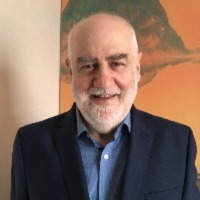
Speaker: Gunther Uhlmann
Date of Presentation: May 4, 2023
Chair: Fioralba Cakoni, Rutgers University
Title: The Calderon Problem: 40 Years Later
Featured article authors: Ru-Yu Lai, Gunther Uhlmann, and Yang Yang
Featured article: "Optimality of Increasing Stability for an Inverse Boundary Value Problem", SIAM J Math Analysis 53 (6) pp. 7062-7080 (2021).
Featured article authors: Pu-Zhao Kow, Gunther Uhlmann, and Jenn-Nan Wang
Abstract: Calderon's inverse problem asks whether one can determine the conductivity of a medium by making voltage and current measurements at the boundary. This question arises in several areas of applications including medical imaging and geophysics. I will report on some of the progress that has been made on this problem since Calderon proposed it, including recent developments on similar problems for nonlinear equations and nonlocal operators. We will also discuss several open problems.
Biography: Gunther Uhlmann is a Walker Family Endowed Professor of Mathematics at University of Washington and IAS Si Yuan Professor at the Hong Kong University of Science and Technology. His research focuses on inverse problems and imaging, partial differential equations and invisibility. He has been recognized for his fundamental contribution to the theory of inverse problems with several prizes, including the Bôcher Memorial Prize from American Mathematics Society (AMS), the Ralph E. Kleinman prize from the Society for Industrial and Applied Mathematics (SIAM), the George David Birkhoff Prize jointly from AMS and SIAM. He is member of the American Academy of Arts and Sciences, corresponding member of the Chilean Academy of Sciences, and foreign member of the Finnish Academy of Science. He is an ISI Highly Cited Researcher, an AMS Fellow, a SIAM Fellow, a Simons Fellow, a Guggenheim Fellow, and a Fellow of the Institute of Physics.
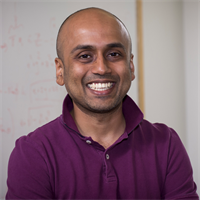
Speaker: Gautam Iyer
Date of Presentation: April 6, 2023
Chair: Gianluca Crippa, Basel University, Switzerland
Title: Using mixing to accelerate convergence of Langevin systems, and applications to Monte Carlo methods
Abstract: The overdamped Langevin equation is a stochastic differential equation that governs the dynamics of a particle driven by the gradient of a potential and small random fluctuations. One extremely useful feature of this equation is that the stationary distribution is proportional to $p = e^{-V/\kappa}$, where $V$ is the potential and~$\kappa$ is the size of the noise. This is the basis of Langevin Monte Carlo algorithm, which samples from the distribution p by taking time averages of the overdamped Langevin equation. Unfortunately, when $V$ has many local minima, this can take an exponentially large (i.e. of order $e^{C/\kappa}$) amount of time to converge to the stationary distribution. I will talk about a method that introduces a "mixing drift" into this system which makes it converge to the stationary distribution rapidly (in time which is a polynomial in $1/\kappa$). This is joint work with Alex Christie, Yuanyuan Feng and Alexei Novikov.
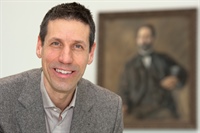
Speaker Name: László Székelyhidi
Date of Presentation: March 2, 2023
Chair: Roman Shvydkoy, University of Illinois
Title: Magnetohydrodynamic turbulence : weak solutions and conserved quantities
Abstract: The ideal magnetohydrodynamic system in three space dimensions consists of the incompressible Euler equations coupled to the Faraday system via Ohm’s law. This system has a wealth of interesting structure, including three conserved quantities : the total energy, cross-helicity and magnetic helicity. Whilst the former two are analogous (and analytically comparable) to the total kinetic energy for the Euler system, magnetic helicity is known to be more robust and of a different nature. In particular, when studying weak solutions, Onsager-type conditions for all three quantities are known, and are basically on the same level of 1/3-differentiability as the kinetic energy in the ideal hydrodynamic case for the former two. In contrast, magnetic helicity does not require any differentiability, only L3 integrability. From the physical point of view this difference lies at the heart of the Taylor-Woltjer relaxation theory. From the mathematical point of view it turns out to be closely related to the div-curl structure of the Faraday system. In the talk we present and compare some recent constructions of weak solutions and along the way highlight some of the hidden structures in the ideal magnetohydrodynamic system. This is joint work with Daniel Faraco and Sauli Lindberg.
Biography: László Székelyhidi is professor for applied mathematics at the University of Leipzig and Director at the Max Planck Institute for Mathematics in the Sciences. Previously, he held visiting professor positions at the Hungarian Academy of Sciences in Budapest and at the Institute for Advanced Study in Princeton, New Jersey. He studied mathematics at Oxford University and received his Ph.D. 2004 in Leipzig. He was a Heinz Hopf Lecturer at ETH Zürich and subsequently Bonn Junior Fellow in Bonn, before moving back to Leipzig.
He is an elected member of the Leopoldina and recipient of the Gottfried Wilhelm Leibniz Prize 2018. He was an invited speaker at the 2014 ICM in Seoul and a plenary speaker at the 2015 ICMP in Chile. Alongside Camillo De Lellis, he was the recipient of the 2013 SIAM Activity Group on Analysis of Partial Differential Equations Best Paper Prize for their work on the Euler equations.
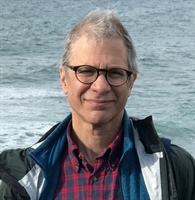
Speaker Name: Michael Weinstein
Date of Presentation: February 2, 2023
Chair: Carlos Tomei, PUC-Rio, Brazil
Title: Effective gaps for time-periodic Hamiltonians modeling Floquet materials
Featured article: "Effective gaps in continuous Floquet Hamiltonians", SIAM J Math Analysis 54 (1) (2022).
Featured article authors: Amir Sagiv and Michael Weinstein
Abstract: Floquet media are a type of material, in which time-periodic forcing is applied to alter the material’s energy transport properties. Examples in classical and quantum physics include (i) applying a time-oscillating electric field to a graphene sheet to influence quantum electronic transport, and (ii) replacing a periodic array of standard optical waveguides by an array of helically coiled waveguides to influence the flow of light propagation in the array. The ability to modify energy transport via time modulation is recognized as having great potential for applications to information transfer, information processing, and other applications.
We discuss Floquet materials governed by a class of parametrically forced Schrödinger equations, which arises in the above examples:
i ψt = Hε (t) ψ, Hε(t) = H0 + ε W ( ε t , -i ∇ ). (1)
The operator H0 = - Δ + V ( x ) models a graphene-like static material; the potential V has the symmetries of a honeycomb tiling of the plane. The family of self-adjoint operators T ↦ W ( T, -i ∇ ) is assumed to be Tper – periodic.
While the energy transport of the unforced system ( W ≡ 0 ) is governed by the band structure (Floquet-Bloch spectral theory) of H0 , that of the forced system is characterized by the monodromy operator, the unitary mapping ψ0 ↦ ψ ( ε-1 Tper ) , and its associated quasi-energy spectrum. Gaps in the band spectrum and quasi-energy spectrum, respectively, of static and Floquet materials, play an important role in their transport properties.
The evolution under Hε (t) of band-limited Dirac wave-packets (a natural model of physical excitations) is well-approximated on very large time scales by an effective time-periodic Dirac equation, which has a gap in its quasi-energy spectrum. But little is known about the nature of the quasi-energy spectrum of (1), and it is believed that no such quasi-energy gap occurs.
We explain how to transfer quasi-energy gap information about the effective Dirac dynamics to conclusions about the full Schrödinger dynamics (1). In particular, we show that (1) has an effective quasi-energy gap, an interval of quasi-energies whose corresponding modes have only a very small spectral projection onto the subspace of band-limited Dirac wave-packets. The notion of effective quasi-energy gap is a physically relevant relaxation of the strict notion of quasi-energy spectral gap. Physically, if a system is tuned to drive or measure at momenta and energies near the Dirac point of H0 , then the resulting modes in the effective quasi-energy gap will only be weakly excited and detected.
This lecture focuses on joint work with Amir Sagiv (Columbia University) appearing in the article: Effective gaps in continuous Floquet Hamiltonians, SIAM J Math Analysis 54 (1) (2022).
Biography: Michael I. Weinstein is professor of applied mathematics in the applied physics and applied mathematics department, and professor of mathematics in the department of mathematics at Columbia University. He received his Ph.D. at the Courant Institute under the direction of George C. Papanicolaou, and was a postdoctoral fellow at Stanford University with Joseph B. Keller. Before coming to Columbia University in 2004, Weinstein held positions at Princeton University (1984-88), the University of Michigan (1988-98), and in the Fundamental Mathematics Research Group at Bell Laboratories, Lucent Technologies (1998-2004). He is a SIAM Fellow (2010), a Fellow of the AMS (2014), and was awarded the SIAM Activity Group on Nonlinear Waves and Coherent Structures Martin Kruskal Prize Lecture in 2018. Since 2015, Weinstein has been a Simons Foundation Math + X Investigator (2015-2025).
2022
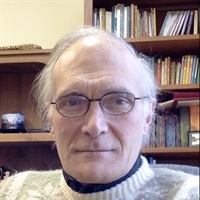
Speaker Name: Alberto Bressan
Date of Presentation: December 1, 2022
Chair: Hermano Frid, IMPA, Brazil
Title: On the optimal shape of tree roots and branches
Featured article: Optimal Shapes for Tree Roots, SIAM J. Math. Anal. 54(4) (2022), pp. 4757-4784.
Featured article authors: Alberto Bressan, Sondre T. Galtung and Qing Su
Abstract: Living organisms come in an immense variety of shapes. In many cases one can expect that, through natural selection, a "best possible shape" will have evolved. From a mathematical perspective, it is thus of interest to understand whether similar geometric shapes can be recovered as minimizers of suitable functionals.
As a step in this direction, we consider two functionals measuring the efficiency of roots and branches in a tree. Namely:
(i) a "sunlight functional", modeling the total amount of sunlight captured by the leaves of a tree, and
(ii) a "harvest functional", modeling the amount of nutrients collected by the roots.
The above functionals must be combined with a "ramified transportation cost", for transporting nutrients from the roots to the base of the trunk, or from the base of the trunk to the leaves.
The talk will address the semicontinuity of these functionals, and the existence and properties of optimal solutions, in a space of measures. Open problems will also be discussed, including computational issues and how these optimal shapes may depend on various parameters.
Biography: Alberto Bressan is the Eberly Family Chair Professor of mathematics at Penn State University. Formerly he was a professor at S.I.S.S.A. in Trieste, Italy. His main research interests are hyperbolic conservation laws, nonlinear PDEs, control theory, optimization, and differential games. Bressan was a plenary speaker at the 2002 ICM in Beijing; furthermore, he was awarded the SIAM Activity Group on Analysis of Partial Differential Equations Prize in 2007, the AMS M. Bôcher prize in 2008, and the Gaetano Fichera Prize for mathematical analysis by the Italian Mathematical Union in 2011.
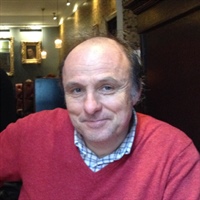
Speaker Name: Patrick Gérard
Date of Presentation: November 3, 2022
Chair: Natasa Pavlovic, University of Texas at Austin, U.S.
Title: A survey of the Benjamin-Ono equation with periodic boundary conditions
Abstract: The Benjamin-Ono equation is a nonlinear dispersive wave equation in one space dimension, introduced in 1967 as a model for long internal gravity waves in a two layer fluid with infinite depth. In this talk, I will show how the use of a Lax pair provides a fairly complete picture of the dynamics with periodic boundary conditions. I will discuss an explicit formula for the solutions, global well posedness in sharp regularity, long time dynamics, the classification of traveling waves, of multi-solitons and of doubly periodic solutions, and the smoothing effect. This talk is inspired from a series of jointworks with Thomas Kappeler and Petar Topalov.
Biography: Patrick Gérard is currently a professor at the Orsay mathematics department of the Université Paris-Saclay, and a former director of this department. He has been an assistant professor at Ecole Normale Supérieure and a part time professor at Ecole Polytechnique. His research interests lie in evolution PDEs, with a focus on high frequency phenomena and on long time nonlinear dynamics. He received the Servant Prize in 1998 and the Leonid Frank Prize in 2014 from the French Academy of Sciences. He was a speaker at ECM 2004 (Stockholm) and at ICM 2006 (Madrid).
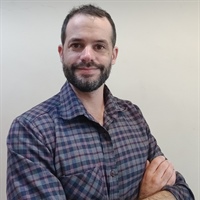
Speaker Name: Jacob Bedrossian
Date of Presentation: October 6, 2022
Chair: Clément Mouhot, University of Cambridge, U.K.
Title: Landau damping and related effects in kinetic models of plasma physics
Featured article authors: Jacob Bedrossian, Nader Masmoudi and Clément Mouhot
Abstract: In this talk I will attempt to overview past and recent progress in understanding asymptotic stability in collisionless and weakly collisional plasmas. Results such as Landau damping, plasma echoes, and collision-enhanced dissipation will be discussed followed by discussions of some open directions.
Biography: Jacob Bedrossian received his Ph.D. in 2011 from the University of California, Los Angeles. He is currently a professor at the University of Maryland, College Park. He received a Sloan Fellowship in 2015, an NSF CAREER grant in 2016, the 2019 IMA prize, the 2019 SIAM Activity Group on Analysis of Differential Equations prize with Nader Masmoudi, and the 2020 Peter Lax Award. He was an invited speaker at the ICM-2022.
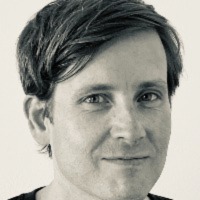
Speaker Name: Scott Armstrong
Date of Presentation: September 1, 2022
Chair: Paul Dario, University of Lyon 1, France
Title: Coarse-graining, renormalization, and quantitative homogenization
Abstract: I will present an overview of the theory of quantitative homogenization (stochastic as well as periodic) for elliptic and parabolic equations, which has been developed in the last ten years. A particular emphasis will be on the idea of "coarse-graining the coefficient field" with applications to degenerate equations and other situations which require "renormalization," including some more recent applications to models in mathematical physics. Time permitting, I will discuss what I see as some of the most important open problems in the subfield.
Biography: Scott Armstrong is currently Professor of Mathematics at the Courant Institute, NYU. His research interests lie in PDEs, probability and mathematical physics with a focus on homogenization. He received his Ph.D. from UC Berkeley in 2009 and has previously held positions at the CNRS (hosted by Paris-Dauphine/PSL), UW-Madison, the University of Chicago and LSU.
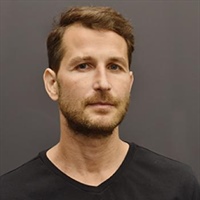
Speaker Name: Igor Rodnianski
Date of Presentation: July 7, 2022
Chair: Pierre Raphael, University of Cambridge, U.K.
Title: Linear and nonlinear stability problems for the Vlasov-Poisson equations
Featured Article Authors: Emmanuel Grenier, Toan T. Nguyen, and Igor Rodnianski
Abstract: I will discuss the issues in and around problems of stability of spatially homogeneous equilibria in collisionless plasma, including Landau damping and plasma echoes.
Biography: Igor Rodnianski received his Ph.D. in 1999 from Kansas State University. He is currently a Professor at Princeton University, where he was also previously an Instructor and Assistant Professor. His research lies at the intersection of partial differential equations, geometry and mathematical physics. He made contributions to mathematical theory of general relativity, hyperbolic and dispersive equations. He was a recipient of the Clay Fellowship, the Fermat Prize and the Simons Investigator Award. He was an invited speaker at ICM-2006 and a plenary speaker at ICMP-2006.
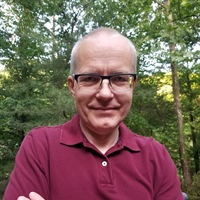
Speaker Name: Alexander Kiselev
Date of Presentation: June 2, 2022
Chair: Omar Lazar, American University of the Middle East, Kuwait and University of Seville, Spain
Title: The flow of polynomial roots under differentiation
Featured Article: Global regularity for a nonlocal PDE describing evolution of polynomial roots under differentiation, to appear, SIAM J. Math Analysis
Featured Article Authors: A. Kiselev, Changhui Tan
Abstract: The question of how roots of polynomials move under differentiation is classical. Contributions to this subject have been made by Gauss, Lucas, Marcel Riesz, Polya and many others. In 2018, Stefan Steinerberger derived formally a PDE that should describe the dynamics of roots under differentiation in certain situations. The PDE in question is of hydrodynamic type and bears a striking resemblance to the models used in mathematical biology to describe collective behavior and flocking of various species - such as fish, birds or ants. The equation is critical, but due to strongly nonlinear form of its coefficients, proving global regularity for its solutions is harder than for equations such as Burgers, SQG or Euler alignment model. I will discuss joint work with Changhui Tan in which we establish global regularity of Steinerberger's equation and make a rigorous connection between its solutions and evolution of roots under differentiation for a class of trigonometric polynomials.
Biography: Alexander Kiselev received his bachelor's degree in 1992 from Saint Petersburg State University and his PhD in 1997 from Caltech under supervision of Barry Simon. In 1997-1998 he was a postdoctoral fellow at the Mathematical Sciences Research Institute, and during 1998-2002 he was an E. Dickson Instructor and then assistant professor at the University of Chicago where he worked with Peter Constantin on reaction-diffusion equations and fluid mechanics. He taught at the University of Wisconsin-Madison from 2002 to 2013, as an associate and full professor. He was a member of the Rice University faculty between 2013 and 2017. Since 2018, Kiselev is a William T. Laprade Professor of Mathematics at Duke University. He has been awarded Guggenheim fellowship in 2012 and has been an invited speaker at ICM-2018.
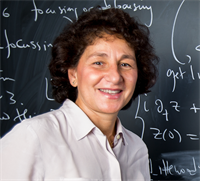
Speaker Name: Andrea R. Nahmod
Date of Presentation: May 5, 2022
Chair: Felipe Linares, IMPA, Brazil
Title: Gibbs measures and propagation of randomness under the flow of nonlinear dispersive PDE
Abstract: In groundbreaking work, Bourgain ’96 put forward a random data theory to study the existence of strong solutions on the statistical ensemble of Gibbs measures associated to dispersive equations. Despite numerous follow-up works to those of Bourgain’s, fundamental questions remained open. How does a given initial random data get transported by a nonlinear flow? If it is Gaussian initially, how does this Gaussianity propagate? What is the description of the solution beyond the linear evolution?
In recent work, joint with Yu Deng and Haitian Yue, we developed the theory of random tensors, a powerful new framework which allows us to unravel the propagation of randomness under the NLS flow beyond the linear evolution of random data, and answer these questions in an optimal range relative to what we define as the probabilistic scaling. In particular, we establish the invariance of Gibbs measures for 2D NLS and 3D Hartree NLS equations using the method of random averaging operators, a first order approximation to the full random tensor theory.
In this talk we will describe these results, and explain the ideas behind them. We conclude with some open problems and within this context present new work, joint with Bjoern Bringmann, Yu Deng and Haitian Yue establishing the invariance of the 3D Gibbs measure under the flow of the nonlinear wave equation.
Biography: Andrea R. Nahmod is Professor of Mathematics at the University of Massachusetts Amherst. Her research lies at the interface of nonlinear Fourier and harmonic analysis, and the theory of partial differential equations. Some of her recent work aims at gaining a quantitative understanding of the propagation of randomness under the nonlinear evolution of dispersive PDE. Nahmod is a Fellow of the American Mathematical Society; a recipient of the Sargent-Faull Fellowship at Harvard’s Radcliffe Institute for Advanced Study, and of a Simons Foundation Fellowship. Nahmod was twice a member of the Institute for Advanced Study at Princeton and held Simons’ Professorships at MSRI, Berkeley and at CRM Montreal. She delivered an invited address at the 2021 Joint Mathematical Meetings of the AMS.

Speaker Name: Martin Hairer
Date of Presentation: April 7, 2022
Chair: Gautam Iyer, Carnegie Mellon University
Title: Directed mean curvature flow in noisy environment
Abstract: We consider the directed mean curvature flow on the plane in a weak Gaussian random environment and show that, when started from a sufficiently flat initial condition, a rescaled and recentred solution converges in a suitable scaling limit to the solution of the KPZ equation. This result follows from the analysis of a more general system of nonlinear stochastic PDEs driven by inhomogeneous noises, using the theory of regularity structures. This is joint work with Andris Gerasimovics (U. Bath) and Konstantin Matetski (U. Columbia).
Biography: Martin Hairer is currently professor at Imperial College London, having previously held positions at the University of Warwick and the Courant Institute at New York University. His main areas of research are stochastic dynamics and the analysis of stochastic PDEs. His work has received numerous awards, including the Fields medal, the Breakthrough prize in mathematics, and the Fermat prize.
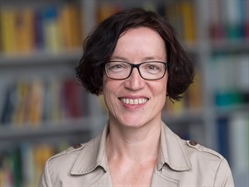
Speaker: Barbara Niethammer
Date of Presentation: March 3, 2022
Chair: Bob Pego, Carnegie Mellon University
Title: An obstacle problem for cell polarization
Featured Article: A parabolic free boundary problem arising in a model of cell polarization. SIAM J. Math. Anal. 53-1 (2021)
Featured Article Authors: A. Logioti, B. Niethammer, M. Röger and J. L. Velázquez
Abstract: We investigate a model for cell polarization under external stimulus where a diffusion equation in the inner cell is coupled to reaction diffusion equations on the cell membrane. In certain scaling limits we rigorously derive generalized obstacle type problems. For these limit systems we prove global stability of steady states and characterize the parameter regime for the onset of polarization. (Joint work with Anna Logioti (Bonn) Matthias Roeger (TU Dortmund) and Juan Velazquez (U Bonn))
Biography: Barbara Niethammer is Professor at the Institute for Applied Mathematics at the University of Bonn. Her research focuses on the analysis of problems with multiple scales and high-dimensional dynamical systems as well as on the study of long-time behaviour in models of mass aggregation. Before moving to Bonn she held faculty positions at the Humboldt-University of Berlin and the University of Oxford. She was invited sectional speaker at the ICM 2014, Emmy-Noether lecturer at the annual DMV meeting in 2019, plenary speaker at the SIAM annual meeting in 2020 and received the von-Mises-Prize of GAMM and the Whitehead prize of the LMS.
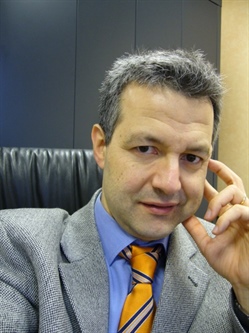
Speaker: François Golse
Speaker Affiliation: École polytechnique, France
Date and Time of Presentation: February 3, 2022, 11:30 a.m. EST
Chair: Mikaela Iacobelli, ETH Zurich, Switzerland
Title: Quantum Dynamics and Optimal Transport
Abstract: In 1979, Dobrushin explained how Monge’s theory of optimal transport (1781) can be used to prove the mean-field limit for the classical dynamics of large particle systems. Is it possible to compare two quantum states, or a quantum state and a classical phase space density by some quantum analogue of optimal transport? in the affirmative, can one use such ideas to study the mean-field and the classical limits of quantum dynamics? This talk will review some recent results in this direction, based on joint works with E. Caglioti, C. Mouhot and T. Paul.
Biography: François Golse is a professor of mathematics at École polytechnique (Paris area, France). His research interests are PDEs and mathematical physics, especially kinetic models and their connection with fluid dynamics, and more recently the quantum dynamics of large particle systems in the classical and mean-field limits. With Laure Saint-Raymond, he has been awarded the first APDE prize of SIAM in 2006. He has given the 1993 Peccot Lectures at Collège de France (Paris) and the 2010 Harold Grad Lecture at the 27th Rarefied Gas Dynamics International Symposium (Pacific Grove, USA). He has been a plenary speaker at the 2004 European Congress of Mathematics (Stockholm) and an invited speaker at the 2006 International Congress of Mathematicians (Madrid).
|
Eitan Tadmor |
|
Eitan Tadmor |
|
Eitan Tadmor |
2021
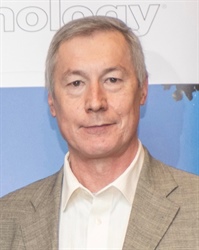
Speaker Name: Andrzej Swiech
Speaker Affiliation: Georgia Tech
Date and Time of Presentation: February 4, 2021, 11:30 am ET
Chair: Diogo Gomes, KAUST, Saudi Arabia
Title and Featured Article in SIAM Journal on Mathematical Analysis: Finite dimensional approximations of Hamilton-Jacobi-Bellman equations in spaces of probability measures.
Featured Article Authors: W. Gangbo, S. Mayorga, A. Swiech
Abstract: We will discuss how certain Hamilton-Jacobi-Bellman (HJB) equations in spaces of probability measures can be approximated by finite dimensional equations. The most interesting cases are convergence of viscosity solutions of HJB equations corresponding either to deterministic optimal control problems for systems of $n$ particles or to stochastic optimal control problems for systems of $n$ particles with a common noise, to the viscosity solution of a limiting HJB equation in the space of probability measures. The limiting HJB equation is interpreted in its "lifted" form in a Hilbert space, which has a unique viscosity solution. When the Hamiltonian is convex in the gradient variable and equations are of first order, it can be proved that the viscosity solutions of the finite dimensional problems converge to the value function of a variational problem in $\mathcal{P}_2(\R^d)$ thus providing a representation formula for the solution of the limiting first order HJB equation. The talk will also contain an overview of existing works and various approaches to partial differential equations in abstract spaces, including spaces of probability measures and Hilbert spaces. The talk is based on a joint work with W. Gangbo and S. Mayorga.
Biography: Andrzej Swiech is a Professor of Mathematics at Georgia Institute of Technology in Atlanta (USA). He received his Ph.D. in 1993 from the University of California, Santa Barbara, under the direction of M.G. Crandall. His main interests are in fully nonlinear PDEs, PDEs in infinite-dimensional spaces, integro-PDEs, viscosity solutions, stochastic and deterministic optimal control, stochastic PDEs, differential games, mean-field games and control, calculus of variations, functional analysis. He received, jointly with S. Koike, 2010 JMSJ (Journal of The Mathematical Society of Japan) Outstanding Paper Prize.
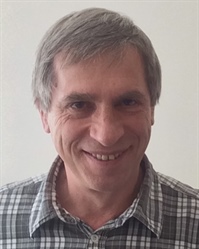
Speaker: Sergei Chernyshenko
Speaker Affiliation: Imperial College London, UK
Date and Time of Presentation: March 4, 2021 11:30 am EST
Chair: Ricardo Rosa, Universidade Federal do Rio de Janeiro, Brasil
Title: Auxiliary functionals: a path to solving the problem of turbulence
Abstract: The problem of turbulence is the greatest unsolved problem of classical fluid dynamics. It is quite old.Similarly, the problem of optimizing over the cone of nonnegative polynomials was long believed to be too hard, until at the start of the millennium a breakthrough paved a way by linking it, through sum-of-squares polynomial optimisation, to semidefinite programming. And only a few years ago, auxiliary functionals were proposed with an ultimate goal of applying the fruits of this breakthrough to solving the problem of turbulence. The essence of these ideas is remarkably simple. The talk will cover the basics, and then a few questions will be reviewed deeper, including applications to systems of equations with energy-conserving quadratic nonlinearities, such as the Kuramoto–Sivashinsky and the Navier-Stokes equations.
Biography: Sergei Chernyshenko is a professor of aerodynamics at Imperial College London, UK. He had previous positions at the University of Southampton, UK, and at the Moscow State University, Russia. His area of expertise is theoretical fluid dynamics, with a scope ranging from rigorous mathematics to practical applications. He solved the long-standing problem of high-Re asymptotics of steady separated flow past a bluff body, and made contributions to the theory of organised structures in turbulent flows, methods of turbulent skin friction reduction, theory of scale interactionin near-wall turbulence, and theory of bounding time averages of dynamical systems. He received the USSR State Committee for People Education Award in research (shared), the Joukowski Award in aerodynamics (also shared), and was twice awarded the Russian State Stipend for Outstanding Scientists.
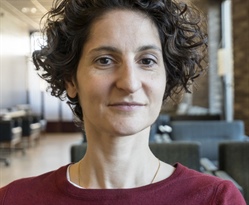
Speaker: Sylvia Serfaty
Speaker Affiliation: Courant Institute of Mathematical Sciences, NYU
Date and Time of Presentation: April 1, 2021 11:30 am EDT
Chair: Didier Smets, Sorbonne Université, LJLL
Title: Ginzburg-Landau, old and new
Abstract: This talk will review older and more recent results on the analysis of vortices in the Ginzburg-Landau model of superconductivity, including description of energy minimizers and their vortex patterns in both two and three dimensions, and description of vortex dynamics.
Biography: Sylvia Serfaty is Silver Professor at the Courant Institute of Mathematical Sciences of New York University. Prior to this she has been Professor at the Université Pierre et Marie Curie (currently Sorbonne Université) at the Laboratoire Jacques-Louis Lions, and has held various appointments at the Courant Institute of NYU. She earned her BS and MS in Mathematics from the École Normale Supérieure in Paris, and her PhD from Université Paris Sud. She works in calculus of variations, nonlinear partial differential equations, and mathematical physics. She was a plenary speaker at the International Congress of Mathematicians in 2018, the recipient of the EMS and Henri Poincaré prizes, and is a member of the American Academy of Arts and Sciences.
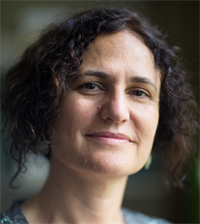
Speaker: Gigliola Staffilani
Speaker Affiliation: Massachusetts Institute of Technology
Date and Time of Presentation: May 6, 2021 11:30 am EDT
Chair: Luis Vega (BCAM, Spain)
Title: How much math do you need to know to “solve" an initial value problem?
Abstract: In this talk I will present some recent results concerning periodic solutions to nonlinear Schrodinger equations, and in doing so I will introduce a variety of mathematical techniques that range from harmonic and Fourier analysis to dynamical systems, from number theory to probability.
I will start with a derivation of this type of equation from a many body system, and I will discuss how Hamiltonian structures can be mapped through this derivation process. I will then move to the study of the long time dynamics of associated initial value problems, in particular I will concentrate on the notion of energy transfer. I will show how ideas from dynamical systems are fundamental to work through this analysis to obtain even relatively soft statements, and I will present some more recent results on the rigorous derivation of a wave kinetic equation for a certain multidimensional KdV type equation using a variety of tools such as Feynman diagrams, sharp dispersive estimates and improved combinatorial lemmata.
Biography: Gigliola Staffilani is the Abby Rockefeller Mauze Professor of Mathematics at MIT since 2007. She received the B.S. equivalent from the University of Bologna, and the M.S. and Ph.D. degrees from the University of Chicago. Following a Szegö Assistant Professorship at Stanford, she had faculty appointments at Stanford, Princeton and Brown before joining the MIT mathematics faculty in 2002. Professor Staffilani is an analyst, with a concentration on dispersive nonlinear PDEs. At Stanford, she received the Harold M. Bacon Memorial Teaching Award in 1997, and was given the Frederick E. Terman Award for young faculty in 1998. She was a Sloan fellow in 2000-02. Professor Staffilani was member of the Institute for Advanced Study in Princeton in 1996 and 2003, and member of the Radcliffe Institute for Advanced Study at Harvard University in 2010.
In 2013 Professor Staffilani was elected member of the Massachusetts Academy of Science and a fellow of the AMS, and in 2014 member of the American Academy of Arts and Sciences. In 2017 she received a Guggenheim fellowship and a Simons Fellowship in Mathematics. In 2018 she received the MIT Earll M. Murman Award for Excellence in Undergraduate Advising.
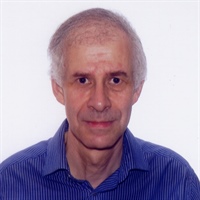
Speaker: Yann Brenier
Speaker Affiliation: École Normale Supérieure, Paris
Date and Time of Presentation: June 3rd, 2021 11:30 am EDT
Chair: Alexis Vasseur, University of Texas, Austin
Title and Featured Article in SIAM Journal on Mathematical Analysis: On optimal transport of matrix-valued measures?
Featured Article Authors: Yann Brenier, Dmitry Vorotnikov
Abstract: We suggest a way of defining optimal transport of positive-semidefinite matrix-valued measures, inspired by a recent rendering of the incompressible Euler equations and related conservative systems as concave maximization problems. The main output of our work is a matricial analogue of the Hellinger-Kantorovich metric spaces.
Biography: Yann Brenier is Directeur de Recherches au CNRS, at Ecole Normale Superieure, Paris. Before, he has been a junior researcher at INRIA, a Hedrick assistant professor at UCLA, before becoming a professor jointly at Universite Paris 6 and Ecole Normale Superieure. Then, he became a Directeur de Recherches CNRS, first at Universite de Nice and later at Ecole Polytechnique, Palaiseau.
His research activities concern partial differential equations, with a special interest for Fluid Mechanics and Optimal Transport theory. He was a plenary speaker ICIAM (Sydney 2003), sectional speaker at ICM (Beijing 2002) and was awarded the Prize Petit d'Ormoy by the French Academy of Sciences in 2005.
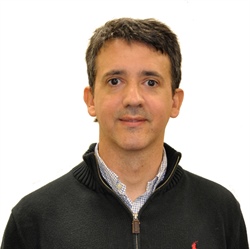
Speaker: Luis Silvestre
Speaker Affiliation: University of Chicago
Date and Time of Presentation: July 1st, 2021 11:30 a.m. EDT
Chair: Boyan Sirakov, Catholic University Rio de Janeiro - PUC-Rio
Title based on a Featured Article from SIAM Journal on Mathematical Analysis: Gaussian lower bounds for the Boltzmann equation without cut-off
Featured Article Authors: Cyril Imbert, Clément Mouhot, Luis Silvestre
Abstract: The Boltzmann equation models the evolution of densities of particles in a gas. Its global well posedness is a major open problem, facing comparable difficulties as similar questions for equations in fluids. With current techniques, we cannot rule out the possibility of a spontaneous emergence of a singularity in the form of infinite mass or energy density concentrating at some point in space. This work is part of a series of a priori estimates for the inhomogeneous non-cutoff Boltzmann equation that are conditional to bounds on macroscopic quantities. We establish a Gaussian lower bound for solutions to the Boltzmann equation without cutoff, in the case of hard and moderately soft potentials, with spatial periodic conditions, and under the sole assumption that hydrodynamic quantities (local mass, local energy and local entropy density) remain bounded. In the talk, we will discuss how this lower bound fits in the larger program of conditional estimates.
Biography: Luis Silvestre is a professor of mathematics at the University of Chicago. In 2005, he received his Ph.D. from the University of Texas at Austin. He was a Courant Instructor at NYU from 2005 to 2008. He got the Sloan research fellowship in 2009, a CAREER NSF grant in 2013, was an invited speaker at the ICM in 2014 and a plenary speaker in the Riviere-Fabes symposium in 2017. His interests include elliptic regularity, integro-differential equations, kinetic equations and conservation laws.
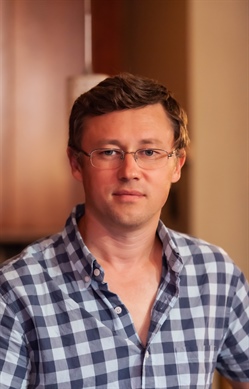
Speaker: Roman Shvydkoy
Speaker Affiliation: University of Illinois, Chicago
Date and Time of Presentation: September 2nd, 2021 11:30 a.m. ET
Chair: Jose Antonio Carrillo (University of Oxford, UK)
Title: Analytical aspects of emergent dynamics in systems of collective behavior
Abstract: One of the challenging problems in the field of collective behavior is to understand global emergent phenomena arising from purely local communication between agents. In the context of alignment dynamics examples of such global phenomena include flock formations, reaching consensus of opinions, emergence of leaders, etc. For models based on purely local interactions the assumption of graph-, chain-, or hydrodynamic connectivity of the flock is often necessary, but not always guaranteed, to ensure collective outcome. In this talk we will give an overview of the subject and highlight two new approaches to alignment dynamics in disconnected or weakly connected flocks. One is based on a topological fractional diffusion that resembles the closest neighbor rule originating in various empirical studies, and another based on the use of random fluctuations and the hypocoercivity property for the resulting kinetic Fokker-Planck-Alignment equation.
Biography: Roman Shvydkoy is currently a Professor of Mathematics at the University of Illinois at Chicago. He held visiting positions at Courant Institute of Mathematical Sciences, Princeton University and Instituto de Ciencias Matematicas at Madrid. His research focuses on the analysis of PDEs arising in fluid dynamics and flocking. He is a recipient of the Simons Fellows in Mathematics award in 2018.
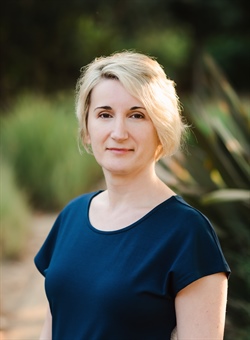
Speaker: Monica Visan
Speaker Affiliation: University of California, Los Angeles
Date and Time of Presentation: October 7th, 2021 11:30 a.m. ET
Chair: Piero D'Ancona (University of Rome La Sapienza)
Title: Determinants, commuting flows, and recent progress on completely integrable systems
Abstract: We will survey a number of recent developments in the theory of completely integrable nonlinear dispersive PDE. These include a priori bounds, the orbital stability of multisolitons, well-posedness at optimal regularity, and the existence of dynamics for Gibbs distributed initial data. I will describe the basic objects that tie together these disparate results, as well as the diverse ideas required for each problem.
Biography: Monica Visan is a professor of mathematics at the University of California, Los Angeles. She received her undergraduate degree from the University of Bucharest in 2002. In 2006, she received her PhD degree from UCLA and was awarded a Clay Liftoff Fellowship. She was a member at the Institute for Advanced Study in Princeton from 2006 to 2008, and an Assistant Professor at the University of Chicago from 2008 to 2009. In 2010, she was awarded a Harrington Fellowship and a Sloan Research Fellowship. She became a Kavli Fellow in 2010. At UCLA, she received the Sorgenfrey Distinguished Teaching Award in 2018.
Professor Visan is an analyst working in nonlinear dispersive PDE, harmonic analysis, and completely integrable systems. Her early work centered around treating nonlinear dispersive equations at the scaling-critical regularity. More recently, she and her collaborators have developed new techniques that have proven effective at advancing the theory of completely integrable systems, including settling the optimal well-posedness problems for several much-studied equations such as the Korteweg-de Vries and the cubic nonlinear Schrodinger
equations.
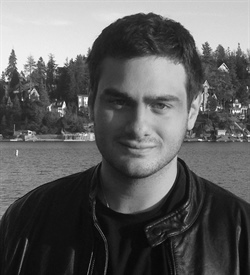
Speaker: Theodore Drivas
Speaker Affiliation: Stony Brook University
Date and Time of Presentation: November 4th, 2021 11:30 a.m. ET
Chair: Alexei Mailybaev (IMPA, Rio de Janeiro)
Title: Compressible fluids, entropy hierarchies, and flocking
Abstract: We will discuss two types of one-dimensional compressible fluid equations; Navier-Stokes models with local dissipation in which the viscosity depends degenerately on the density and nonlocal models for collective dynamics which exhibit flocking behavior. For the local models, we prove large data global regularity for a class of equations covering viscous shallow water. Another result proves a conjecture of Peter Constantin on singularity formation for a model describing slender axisymmetric fluid jets. For the non-local models, we establish a continuation criterion which says that smooth solutions exist so long as no vacuum states form. The method of proof involves introducing a hierarchy of entropies to control the solution in terms of the minimum density. We also show that any weak solutions which obeying an entropy inequality exhibit flocking. This reports on joint work with P. Constantin, H. Nguyen, F. Pasqualotto and R. Shvydkoy.
Biography: Theodore Drivas is currently an Assistant Professor of Mathematics at Stony Brook University. He received his B.S. degree from the University of Chicago in 2011 and his Ph.D. from Johns Hopkins University in 2017. Prior to arriving at Stony Brook in 2020, he was an NSF MSPRF postdoctoral fellow and subsequently Assistant professor at Princeton University. His research interests include mathematical fluid dynamics, turbulence theory, and dynamical systems.
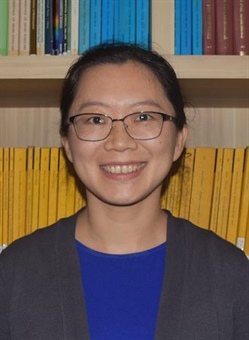
Speaker: Yao Yao
Speaker Affiliation: National University of Singapore
Date and Time of Presentation: December 2, 2021, 11:30 a.m. ET
Chair: Michele Coti Zelati (Imperial College London, UK)
Title: Symmetry and uniqueness via a variational approach
Abstract: For some nonlocal PDEs, their steady states can be seen as critical points of some associated energy functional. Therefore, if one can construct perturbations around a function such that the energy decreases to first order along the perturbation, this function cannot be a steady state. In this talk, I will discuss how this simple variational approach has led to some recent progress in the following equations, where the key is to carefully construct a suitable perturbation.
I will start with the aggregation-diffusion equation, which is a nonlocal PDE driven by two competing effects: nonlinear diffusion and long-range attraction. We show that all steady states are radially symmetric up to a translation (joint with Carrillo, Hittmeir and Volzone), and give some criteria on the uniqueness/non-uniqueness of steady states within the radial class (joint with Delgadino and Yan). I will also discuss the 2D Euler equation, where we aim to understand under what condition must a stationary/uniformly-rotating solution be radially symmetric. Using a variational approach, we settle some open questions on the radial symmetry of rotating patches, and also show that any smooth stationary solution with compactly supported and nonnegative vorticity must be radial (joint with Gómez-Serrano, Park and Shi).
Biography: Yao Yao is currently an Associate Professor of Mathematics at the National University of Singapore. She received her BS degree from Peking University in 2007, and PhD degree in 2012 from UCLA. She was a Van Vleck Visiting Assistant Professor at University of Wisconsin-Madison in 2012-2015, and an Assistant Professor at Georgia Institute of Technology in 2015-2021. Her research focuses on the analysis of partial differential equations arising in mathematical biology and fluid dynamics, especially on the equations with a nonlocal transport term. She was a recipient of the NSF CAREER Award in 2018 and Sloan Research Fellowship in 2020.
2020
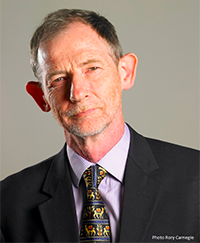
Speaker: John Ball
Title: Some energy minimization problems for liquid crystals
Date of Presentation: June 4, 2020
Chair: Doug Arnold, University of Minnesota
Abstract: The talk will discuss some energy minimization problems for liquid crystals described at different levels of detail by the probability density function of molecular orientations, by a tensor average of this function (the de Gennes Q tensor theory), and by the expected orientation of molecules (the Oseen-Frank theory).
Biography: John Ball is Professor of Mathematics at Heriot-Watt University, Edinburgh, Emeritus Professor at the University of Oxford and Senior Fellow of the Hong Kong Institute for Advanced Study. His research interests lie in nonlinear analysis, the calculus of variations, infinite-dimensional dynamical systems, and their applications to materials science, including solid phase transformations and liquid crystals. He is a former President of the International Mathematical Union.
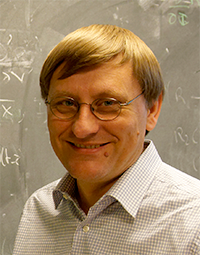
Speaker: Benoit Perthame
Title: Multiphase models of living tissues and the Hele-Shaw limit
Date of Presentation: July 2, 2020
Chair: François Golse, Ecole Polytechnique
Abstract: The mechanical modeling of living tissues has attracted much attention in the last decade. Applications include tissue repair and growth models of solid tumors. These models contain several levels of complexity, both in terms of the biological and mechanical effects, and therefore in their mathematical description. Multiphase models describe the dynamics of several types of cells, liquid, fibers (extra-cellular matrix) and both compressible and incompressible models are used in the literature.
In this talk I shall discuss the analysis of multiphase models based on Darcy's assumption. The compactness issue leads us to use Aronson-Benilan estimate and to build new variants. I shall also discuss the incompressible limit in special cases and the associated free boundary problem.
Biography: Benoit Perthame is a professor of mathematics at Sorbonne Universite in Paris and former director of the Laboratoire Jacques-Louis Lions. Before, he has been a professor at Ecole Normale Superieure and the founder of the team Bang at Institut National de la Recherche en Informatique et Automatique, a team focussed on mathematical modeling in life sciences. His research activities concern partial differential equations, the mathematical objects which serve to relate variations in space and time as they arise in fluid flows and heat transfer. He has introduced a new striking relationship between dilute flows (Boltzman equation) and dense flows (Euler equations). Recently, he has shown the important role played by nonlinear PDEs in a number of problems from biology such as cell motion and cell colonies' self-organization, Darwinian evolution, modeling tumor growth and therapy, and neural networks. He was a plenary speaker ICIAM (Vancouver 2011) and at ICM 2014 (Seoul). He was elected to the French Academy of Sciences in 2017.

Speaker: Felix Otto, Max Planck Institute for Mathematics in the Sciences, Leipzig, Germany
Title: The thresholding scheme for mean curvature flow and De Giorgi's ideas for gradient flows
Date of Presentation: Thursday, September 3, 2020 at 11:30 AM EDT
Chair: David Kinderlehrer, Carnegie Mellon University
Abstract: Flow of interfaces by mean curvature, in its multi-phase version, was first formulated in the context of grain growth in polycrystalline materials. The computationally efficient and very popular thresholding scheme for mean curvature flow by Osher et. al. can be naturally extended to such a multi-phase situation, even for surface tensions that depend on the lattice mismatch between the adjacent grains.
This extension relies on the gradient flow structure of mean curvature flow, and the interpretation of the thresholding scheme as a corresponding "minimizing movements'' scheme, that is, a sequence of variational problems naturally attached to the implicit time discretization of a gradient flow.
This interpretation also allows for a (conditional) convergence proof based on De Giorgi's ideas for gradient flows in metric spaces. The approach is similar to the convergence proof for the minimizing movement scheme by Almgren, Taylor and Wang, as given by Luckhaus et. al.
This is joint work with S. Esedoglu and T. Laux.
Biography: Felix Otto is director at the Max Planck Institute for Mathematics in the Sciences in Leipzig (Germany) since 2010. Before, he has been a professor at the University of California at Santa Barbara and at the Department of Applied Mathematics at the University of Bonn where he was the Managing director of the ‘Hausdorff Center for Mathematics’ from 2006–2009. His main expertise is in the applied analysis of partial differential equations and in the calculus of variations, lately also with randomness. He has worked on gradient flow structures of dissipative evolution equations, on pattern formation in ferromagnets, and on stochastic homogenization. He has received the Max Planck Research Prize, the Leibniz prize of the German Science Foundation, and the Collatz price of CICIAM. Presently, he is chair of the scientific committee at Oberwolfach Research Institute for Mathematics (MFO).
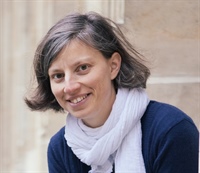
Speaker Name: Laure Saint-Raymond
Speaker Affiliation: École Normale Supérieure de Lyon, France
Date and Time of Presentation: [RESCHEDULED] October 8, 2020 11:30 am EDT
Title: Fluctuation theory in the Boltzmann-Grad limit
Chair: Walter Strauss, Brown University
Abstract: In this talk, I will discuss a long term project with T. Bodineau, I. Gallagher and S. Simonella on hard-sphere gases. In the low density limit, the empirical density obeys a law of large numbers and the dynamics is governed asymptotically by the (kinetic) Boltzmann equation. Deviations from this behavior are described by dynamical correlations, which we can fully characterize for short times. This provides both a fluctuating Boltzmann equation and large deviation asymptotics.
Biography: Laure Saint Raymond is currently a professor at the École Normale Supérieure de Lyon and a Fellow of the Institut Universitaire de France. Before, she has been a professor at the Université de Paris 6 – Pierre et Marie Curie. Her main contributions concern the transition between atomistic and continuous models for gas dynamics through rigorous mathematical analysis. Laure Saint-Raymond has obtained major results concerning the asymptotic theory of the Boltzmann equation in kinetic theory of gases. She has also studied problems of scale separation in the context of geophysical flows, especially for the wind-driven oceanic dynamics. She has been awarded many prizes, among which the SIAG/APDE Prize in 2006, joint with François Golse, the Prize of the European Mathematical Society in 2008, the Ruth Lyttle Satter Prize of the American Mathematical Society in 2009, the Fermat Prize in 2015 and the Bôcher Memorial Prize in 2020. She is a member of the FrenchAcademy of Sciences, the Academia Europae and the European Academy of Sciences.

Speaker Name: Vlad Vicol
Speaker Affiliation: Courant Institute of Mathematical Sciences, NYU, USA
Date and Time of Presentation: November 5th, 2020 11:30 am EST
Chair: Edriss S. Titi, University of Cambridge, Texas A&M, and Wiezmann Institute
Title: Shock formation and vorticity creation for compressible Euler
Abstract: In this talk, I will discuss a long term project, joint with Tristan Buckmaster and Steve Shkoller, concerning the formation of singularities (shocks) for the compressible Euler equations with the ideal gas law. We provide a constructive proof of stable shock formation from smooth initial datum, of finite energy, and with no vacuum regions. Via modulated self-similar variables, the blow-up time and location can be explicitly computed, and at the blow-up time, the solutions can be shown to have precisely Holder 1/3 regularity. Additionally, for the non-isentropic problem sounds waves interact with entropy waves to produce vorticity at the shock.
Biography: Vlad Vicol is currently a Professor of Mathematics at the Courant Institute for Mathematical Sciences, New York University. He received his Ph.D. in 2010 from the University of Southern California in 2010. He taught at the University of Chicago and Princeton University before joining the faculty at the Courant Institute in 2018. His research focuses on the analysis of partial differential equations arising in fluid dynamics, with an emphasis on problems motivated by hydrodynamic turbulence. Vicol is the recipient of an Alfred P. Sloan Research Fellowship, of the MCA Prize at the 2017 Mathematical Congress of the Americas, and a co-recipient of the 2019 Clay Research Award.

Speaker Name: Alessio Figalli
Speaker Affiliation: ETH Zurich, Switzerland
Date and Time of Presentation: Thursday December 3, 2020 11:30 am EST
Chair: Camillo De Lellis (IAS Princeton, USA)
Title: Generic regularity in obstacle problems
Abstract: The classical obstacle problem consists of finding the equilibrium position of an elastic membrane whose boundary is held fixed and constrained to lie above a given obstacle. By classical results of Caffarelli, the free boundary is smooth outside a set of singular points. Explicit examples show that the singular set could be in general (n-1)-dimensional — that is, as large as the regular set. In a recent paper with Ros-Oton and Serra we show that, generically, the singular set has codimension 3 inside the free boundary, solving a conjecture of Schaeffer in dimension $n\leq 4$. This talk aims to give an overview of these results.
Biography: Alessio Figalli earned his doctorate in 2007 under the supervision of Luigi Ambrosio at the Scuola Normale Superiore di Pisa and Cédric Villani at the École Normale Supérieure de Lyon.
He was a faculty at the University of Texas-Austin, before moving to ETH Zürich in 2016 as a chaired professor. Since 2019 he is the director of the “FIM-Institute for Mathematical Research” at ETH Zürich. Figalli has won an EMS Prize in 2012, the Peccot-Vimont Prize 2011, the Peccot 2012 of the Collège de France, the 2015 edition of the Stampacchia Medal, and the 2017 edition of the Feltrinelli Prize for mathematics, and has been appointed Nachdiplom Lecturer in 2014 at ETH Zürich. He was an invited speaker at the International Congress of Mathematicians 2014. In 2018 he won the Fields Medal for “his contributions to the theory of optimal transport, and its application to partial differential equations, metric geometry, and probability”.
Stay Up-to-Date with Email Alerts
Sign up for our monthly newsletter and emails about other topics of your choosing.



